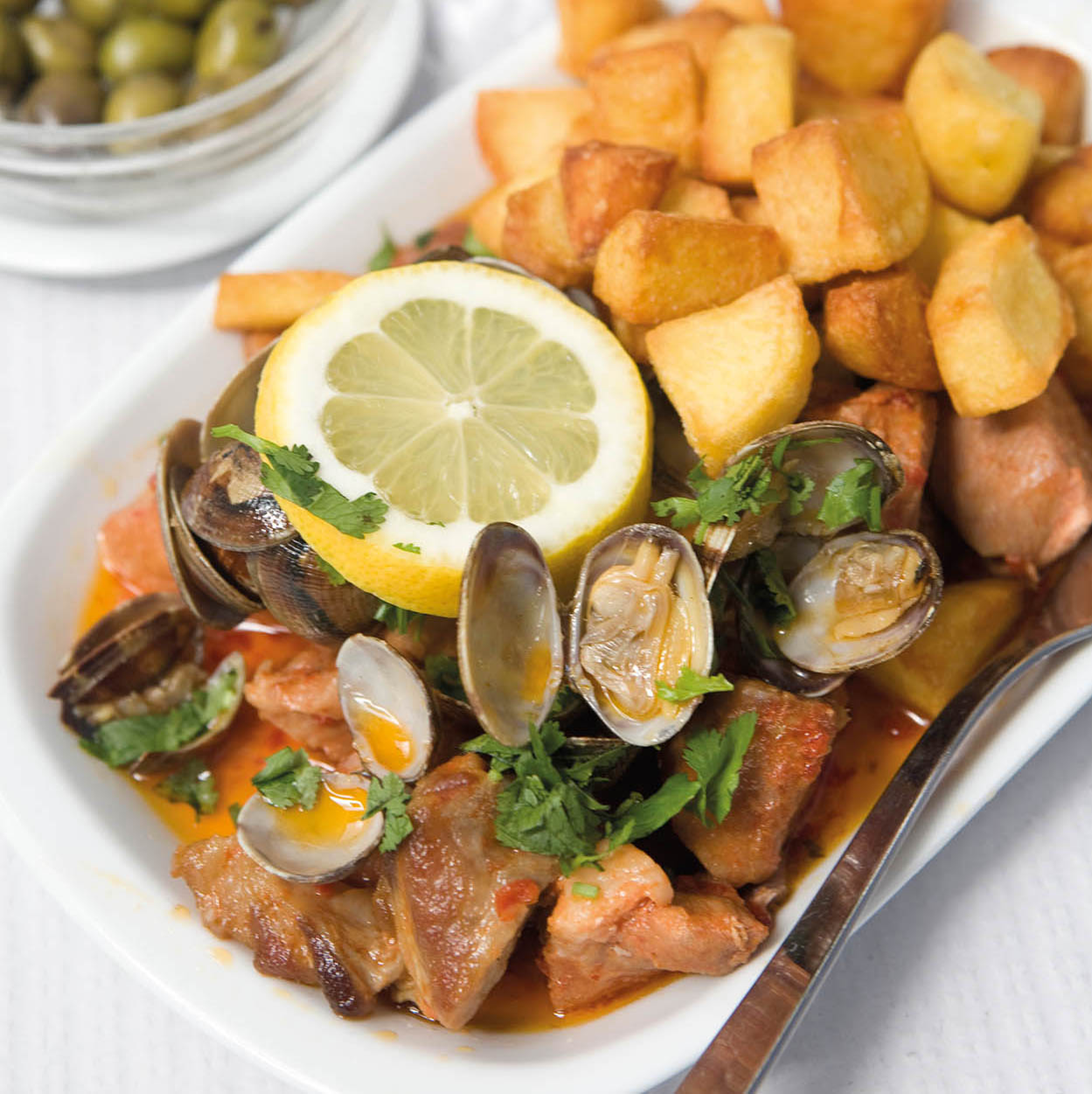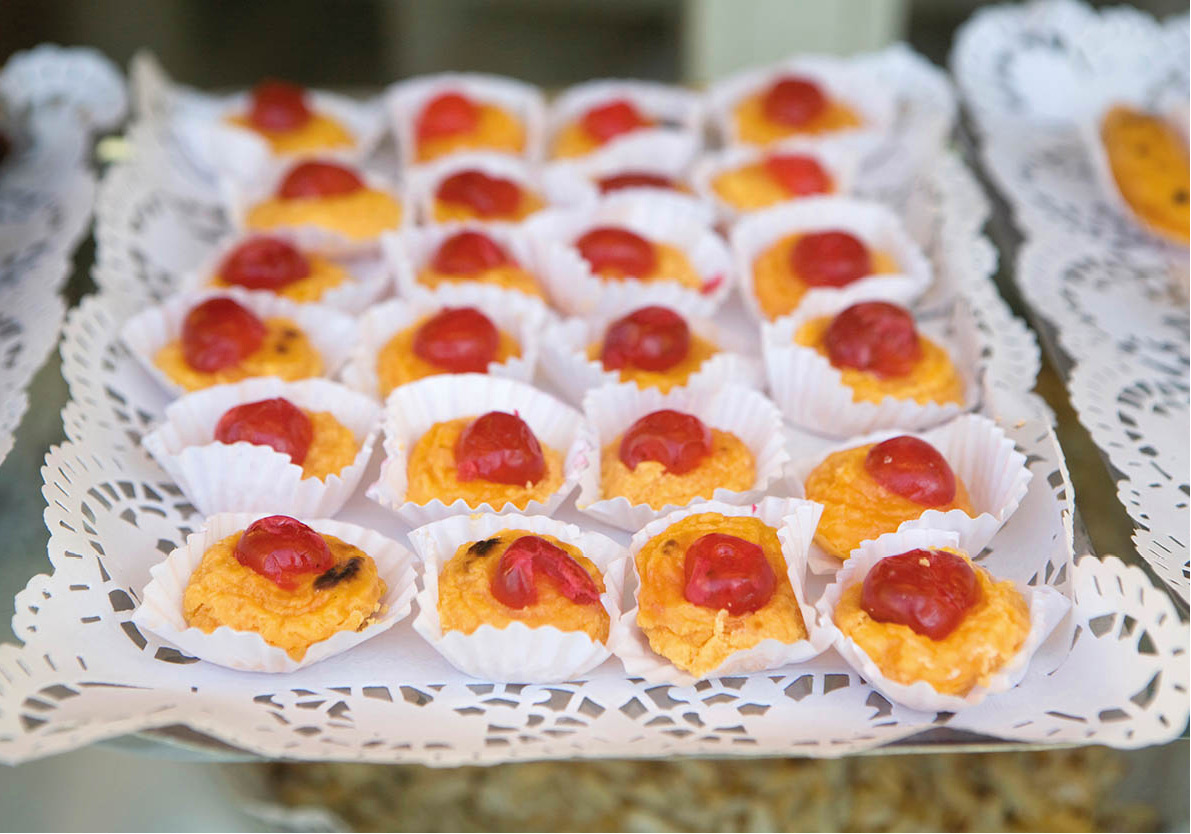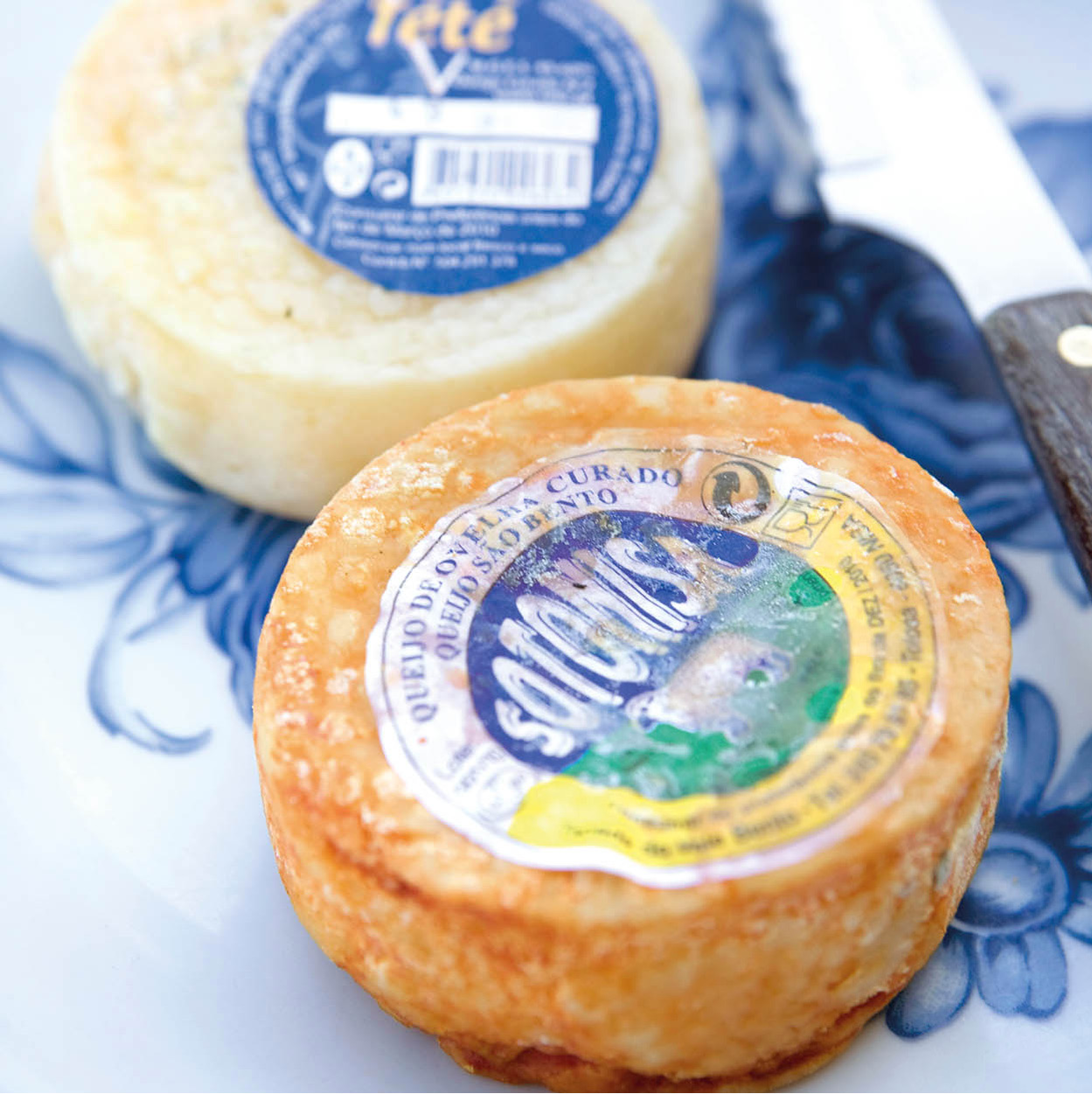Portuguese cuisine is true to its origins, the food of fishermen and farmers. Traditional dishes are found in both expensive restaurants and the simplest of cafés. But the Portuguese can also be very inventive; you’re likely to sample combinations like clams and pork, sole and bananas, or pork and figs.

Carne de porco à Alentejana
Lydia Evans/Apa Publications
Seafood fans are in luck in Portugal, with a surfeit of freshly caught fish and shellfish. The humble but noble Portuguese sardine is an inexpensive standard, especially down south, and with a hunk of local rustic bread and a bottle of house wine, you can still feast well on a small budget.
Restaurants do not skimp on meat either: you can find delicious pork and lamb dishes as well as steak. You’ll also enjoy freshly picked fruit and vegetables, not to mention Portuguese wines, which are eminently drinkable.
Some of the best dishes are regional stews – ensopadas of the Alentejo, caldeiradas of the Algarve and the açordas of Estremadura. These dishes are found in restaurants all over the country.
Portions in Portuguese restaurants tend to be rather large. You can also ask for a half portion (uma meia dose) which is usually charged at around two-thirds of the full price.
Cover charge
Nearly every restaurant in Portugal serves a couvert (literally, cover) – an assortment of appetisers, including bread and butter, that appear to be free but are usually not. Your bill will include a charge of a few euros for the couvert. Theoretically, if you don’t touch them, you should not be charged for them.
Restaurants and Menus
Even the top restaurants are fairly affordable by the standards of European capitals. Menus displayed in the window or beside the door let you know what to expect in variety and price. Prices normally include taxes and a service charge, but it’s customary to leave an additional tip of between 5 and 10 percent for good service. Típico restaurants specialise in local cuisine, marisqueiras feature seafood and churrasqueiras offer barbecued meat.
Many restaurants and cafés offer an ementa turística–tourist menu. The term does not, however, imply a poor-grade international tourist meal. Rather, it is an economically priced set meal–typically bread, butter, soup, main course and dessert. Another inexpensive option at many restaurants and cafés is the prato do dia (dish of the day).
Many restaurants close for the entire month of August.
Meal Times
Breakfast (pequeno almoço) is usually eaten any time up until about 10am. Lunch (almoço) is served from shortly after noon until 3pm and dinner (jantar) runs from 7.30–10pm (or later especially in a casa de fado).
Snacks are usually eaten at a pastelaria (pastry and cake shop), salão de chá (tea shop), or what the Portuguese call by its English name, a ‘snack bar’, a stand-up counter where you can purchase sandwiches, savoury pastries and sweets.
What to Eat
Soups and Starters. When you sit down to a restaurant meal you may be presented with a plate of appetisers, such as cheese or ham, that you haven’t asked for. Note that any of these that you eat will have to be paid for and can be expensive, especially if it is seafood. Lunch and dinner otherwise often get off to a hearty start with soups being typical Portuguese fare. Caldo verde (green soup) is a traditional thick broth of potato purée with finely-shredded cabbage or kale. The best smoked ham (presunto fumado) comes from Chaves, the northernmost province of Portugal. Monchique ham is also highly regarded.

Fresh douradas
Lydia Evans/Apa Publications
Seafood. The best advertisement for seafood is usually the window of a restaurant: a generous refrigerated display case with crabs and prawns, oysters and mussels, sea bass and sole. Seafood restaurants generally sell shellfish by weight, giving the price in euros per kilo. You may wish to have a calculator handy.
Preço V
If you see ‘preço V’ (or simply ‘PV’) beside the seafood or shellfish on a menu, it means that the price is variable depending on the day’s market price. Ask the price before ordering.
A number of seafood dishes are true local specialities. Caldeirada is a rich seafood stew. Amêijoas na cataplana is an invention from the Algarve of steamed mussels (or clams) with sausages, tomato, white wine, ham, onion and herbs. Açorda de marisco is a spicy, garlic-scented thick bread-soup full of seafood bits; raw eggs are later added into the mixture. Lulas recheadas are squid stuffed with rice, olives, tomato, onion and herbs. Sardines (sardinhas) are excellent and generally served grilled (sardinhas assadas). Cod (bacalhau) is the national dish of Portugal, even though it can be expensive and comes dried and salted, and from distant seas.
The Portuguese say that cod is served in 100, 365, or 1,000 different ways (depending on the teller’s taste for hyperbole). One of the best ways to try it is in a tasty bacalhau à Gomes de Sá, in which flaky chunks of cod are baked with parsley, potatoes, onion and olives and garnished with grated hard-boiled egg.

Doces de ovos, one for the sweet-toothed
Lydia Evans/Apa Publications
Fresh fish, whole or filleted, is usually served grilled, as are outstanding atum (tuna) and espadarte, swordfish steaks. For those who know some Spanish or Portuguese, peixe espada might sound like swordfish; however, it is actually scabbard fish, a long, thin fish that comes from the area south of Lisbon. Swordfish is in fact espadarte and smoked swordfish (espadarte fumado) is a little like smoked salmon but with a grainier texture and less sweet.
Meat. Meat is eaten just as much as fish. Bife na frigideira is not what you might think. Frigideira means frying pan, and this dish is a beefsteak nicely done in a wine sauce. Cabrito assado is baked kid served with rice and potato, sometimes heavy-going but delicious. Carne de porco à Alentejana is an inspired dish of clams and pork cooked with paprika and garlic. Espetada mista is a Portuguese shish kebab: chunks of beef, lamb and pork on a spit. Feijoada is the national dish of Brazil, a former Portuguese colony. In Portugal, the dish is not nearly as elaborate or ritualised, but it’s still a tasty stew of pigs’ trotters and sausage, white beans and cabbage. Most meat dishes in Portugal are served with both rice and potatoes.
Cozinha Portuguesa
From starters to stews to sweets, Portuguese food is never bland. From the classiest city establishments to smalltown restaurantes, the Portuguese use herbs and spices (hot peppers only rarely) with a light touch so that flavours are enhanced but not overwhelmed. All the same, the cuisine is robust rather than subtle – and absolutely delicious. Coentros, coriander, is a favourite herb in caldeiradas, or stews, and with fish, too. Each region has its own special dishes: rojões, marinated pork, is popular in the Minho; leitão assado, roast suckling pig around Buçaco and Coimbra; tripas, tripe, in Porto; and clams or mussels steamed in a cataplana (like a closed wok) is a savoury Algarve dish. Alentejo soups might include a raw egg – and can be served to end a meal. Fish and shellfish come fresh from the sea and are sensational. Pudims, tortas and pasteis, sweet puddings, tarts and pastries are found everywhere. Made from eggs, sugar and almonds, they are hard to resist. Pousadas are almost always good bets for regional cuisine.
Game and Fowl. Frango (chicken) is popular and versatile, be it stewed in wine sauce, fried, roasted, or barbecued to a tasty crisp. Some restaurants specialise in game–codorniz (quail), perdiz (partridge), lebre (hare) and even javali (wild boar).
Colonial Dishes. Portugal’s former colony of Goa accounts for the local popularity of caril (curry) and other Indian-style dishes. Piri-piri is a hot-pepper condiment and preparation from Angola that will set most mouths ablaze. Order a piri-piri dish with extreme caution.
Vegetarian Dishes. Vegetarianism has made few inroads in Portugal, and there are not many restaurants dedicated to vegetarians outside the capital and the Algarve. However, vegetable soups are not hard to find and good fresh vegetables are often served as side dishes, including the popular broad beans (favas). Salads are readily available. Salada à Portuguesa is generally made with green peppers, garlic, tomato and cucumber. Omelettes are served everywhere.
Dessert and Cheese. The Portuguese sweet tooth may be a little too much for your taste. Locals pour sugar on a sliced sweet orange, after all. The cakes, custards and pastries are usually made with the basics, egg yolks and sugar, and are delicious. Pudim flã (also flam, flan, or flão) is a Portuguese caramel custard. Custard-cream tarts are a Portuguese speciality found everywhere, but the best are in Belém: pastéis de Belém, crisp pastry casings filled with delectable, secret-recipe cream and topped with a dusting of cinnamon. They’re at their finest from the always-thronged Antigua Confeitaria de Belém, Rua de Belém 84-92, Lisbon, tel: 213 637 423, www.pasteisdebelem.pt.
Of Portuguese cheeses, the most savoury are from ewes’ milk. Serra da Estrela, richest, priciest and rated the best, should be eaten when it’s soft and runny. Small Azeitão cheeses from the Arribada region are full of flavour, as are cheeses made in Serpa and Nisa. Some restaurants offer small hard cheeses as an appetiser. If you prefer cheese at the end of a meal, you might try it with an aguardente velha (old brandy). Also on many menus is Flamengo, a mild cheese that is very similar to Edam.
Some restaurants serve queijo fresco as an appetizer. This is a small, white, soft mini-cheese made of ewes’ and goats’ milk that’s beguilingly creamy.
Wine tasting
It’s great fun to go port or wine tasting, with several fine port centres in Lisbon (for more information, click here) and Porto (for more information, click here), plus wine tours near Setúbal, close to Lisbon (for more information, click here). In Alentejo, there is an Alentejo Wine Route, with recommended adegas (wineries) you can visit; enquire at local tourist offices for details.
Drinks
Table Wines. Portuguese wines are uniformly good, and several regions produce truly excellent wines. House wine (vinho da casa) in restaurants is generally a good bet: tinto is red, rosado pink and branco white.
Under EU regulations there are various categories of wine, including DOC controlled appellation wines produced in a limited geographical region. Wines from the Algarve and Alentejo are good table wines. Dão and Douro wines can be heavier.

The best Portuguese cheeses are from ewes’ milk
Lydia Evans/Apa Publications
Vinho verde from the Minho region is a light, low-alcohol, slightly sparkling young wine that goes down a treat on a sunny lunchtime.
Vinho espumante is Portuguese sparkling wine, packaged in a Champagne-shaped bottle. Most are sweetish but you can find some quite dry versions of it.
Dessert Wines. The two most celebrated Portuguese wines, port and Madeira, named after their places of origin, are mostly known as dessert wines, but they may also be sipped as aperitifs. The before-dinner varieties are dry or extra dry white port and the dry Madeiras, Sercial and Verdelho.
After dinner, try one of the famous ruby or tawny ports (aged tawnys are especially good) or a Madeira dessert wine, Boal or Malvasia (Malmsey).
Other Drinks. Portuguese beers are good and refreshing. Light or dark, they are served chilled, bottled, or from the tap. One of the best and most common is Sagres. You can find various brands of mineral water in small or large bottles, bubbly or still. Portuguese fruit juices can be delicious, and well-known soft drinks are also available.